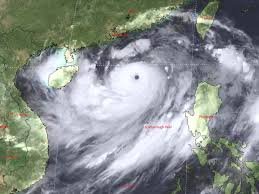Super Typhoon Yagi Hits Southeast Asia: Severe Weather Disruption
Overview of the Impact of Super Typhoon Yagi
Super Typhoon Yagi has struck Southeast Asia, creating widespread damage across several countries, including the Philippines, Vietnam, and Thailand. With wind speeds exceeding 200 km/h, Yagi has triggered flooding, landslides, and power outages, leaving millions of people vulnerable. Emergency response teams have been deployed to assist affected regions as the storm continues to wreak havoc. Governments are coordinating disaster management efforts, focusing on rescue missions, supplying food and medical aid, and ensuring evacuation procedures are followed.
Affected Regions and Evacuation Efforts
The storm has severely affected coastal areas, with communities along the shores facing the brunt of the typhoon’s force. In the Philippines, nearly 500,000 people have been evacuated to temporary shelters, and schools and offices remain closed. Vietnam has also initiated evacuation protocols, particularly in its northern provinces, to safeguard lives. In Thailand, flooding from Yagi has disrupted transportation and communication networks, making rescue operations more challenging.
Economic Consequences of the Typhoon
Beyond the humanitarian crisis, the economic damage from Typhoon Yagi is substantial. Agriculture, infrastructure, and local businesses are facing billions of dollars in losses. In the Philippines, rice and corn crops have been destroyed, which will likely have long-term consequences on food security and trade. Vietnam’s fishing industry has also been affected, as boats have been grounded due to dangerous sea conditions. Immediate international aid is being sought to assist in recovery and rebuilding efforts.
International Support and Aid
Countries like Japan and the United States have extended their support by sending relief supplies and rescue teams to the affected nations. International organizations, including the United Nations, have pledged financial aid and technical assistance in disaster management. These collaborative efforts are vital for the rapid recovery and rebuilding of affected regions, ensuring that basic necessities like food, water, and medical supplies are adequately distributed.
Climate Change and Increasing Super Typhoons
The increasing frequency of super typhoons like Yagi highlights the growing impact of climate change in Southeast Asia. Warmer sea temperatures and changing weather patterns are contributing to stronger storms. Experts have raised concerns about the need for better preparedness and sustainable infrastructure in typhoon-prone regions. As climate change worsens, such catastrophic events may become more frequent, making it imperative for governments and international bodies to invest in long-term disaster resilience strategies.

Why This News is Important for Exam Aspirants
Climate Change and Environmental Awareness
The impact of Super Typhoon Yagi is a stark reminder of the effects of climate change, which is a key topic in government exams. Understanding how global warming contributes to extreme weather patterns and its long-term consequences on vulnerable regions is essential for students preparing for exams, especially in subjects related to geography and environmental studies.
Disaster Management and Government Response
Exam aspirants, especially those preparing for civil service exams, need to be aware of the protocols and policies followed by governments during natural disasters. The coordination of evacuation efforts, international aid, and disaster relief is a crucial aspect of governance, making this news highly relevant for students aiming for administrative roles.
Economic and Humanitarian Impact
Government exams often focus on the economic impact of natural disasters. The losses in agriculture, fisheries, and infrastructure, as well as the humanitarian efforts needed to alleviate suffering, are important points to consider when preparing for exams in fields such as economics, public administration, and social welfare.
Historical Context: Understanding Super Typhoons
The Evolution of Super Typhoons in Southeast Asia
Super typhoons, characterized by sustained wind speeds exceeding 180 km/h, are not new to Southeast Asia. However, their frequency and intensity have increased in recent decades due to climate change. Historically, countries like the Philippines and Vietnam have faced numerous super typhoons, including Typhoon Haiyan in 2013, which caused widespread devastation. This context is important for students to understand the long-term challenges faced by the region in managing such natural disasters.
Global Efforts in Disaster Management
The international community has been actively involved in supporting Southeast Asia’s response to super typhoons. Organizations such as the United Nations and World Meteorological Organization have developed early warning systems and disaster relief protocols that have helped reduce the loss of life and economic damage. Historical events like the 2004 Indian Ocean tsunami also laid the foundation for improved international cooperation in disaster management.
Key Takeaways from the Impact of Super Typhoon Yagi
| S.No | Key Takeaway |
|---|---|
| 1 | Super Typhoon Yagi has caused widespread damage across Southeast Asia, impacting millions of people. |
| 2 | Emergency evacuations and rescue efforts are being coordinated by governments to minimize casualties. |
| 3 | The economic losses from agriculture and infrastructure damage are estimated to be in billions of dollars. |
| 4 | International aid and relief efforts are crucial for the recovery of affected regions. |
| 5 | The increasing frequency of super typhoons is linked to climate change, raising concerns about future preparedness. |
Important FAQs for Students from this News
Q1: What is Super Typhoon Yagi?
A: Super Typhoon Yagi is a powerful tropical cyclone that recently struck Southeast Asia, causing severe damage across multiple countries including the Philippines, Vietnam, and Thailand. It is characterized by extremely high wind speeds and heavy rainfall, leading to significant flooding and destruction.
Q2: Which countries were most affected by Super Typhoon Yagi?
A: The countries most affected by Super Typhoon Yagi include the Philippines, Vietnam, and Thailand. These regions experienced severe flooding, landslides, and extensive damage to infrastructure and agriculture.
Q3: What are the immediate responses to the disaster?
A: Immediate responses include mass evacuations, deployment of emergency response teams, provision of relief supplies, and international aid. Governments are working to rescue affected individuals, restore essential services, and begin the process of rebuilding.
Q4: How does Super Typhoon Yagi relate to climate change?
A: The increasing frequency and intensity of super typhoons, such as Yagi, are linked to climate change. Warmer sea temperatures and altered weather patterns contribute to the development of more powerful storms. This underscores the importance of addressing climate change and enhancing disaster preparedness.
Q5: What are the economic impacts of Super Typhoon Yagi?
A: The economic impacts include extensive damage to agriculture, particularly rice and corn crops, as well as losses in the fishing industry. The destruction of infrastructure and local businesses also results in significant financial losses, requiring substantial recovery and rebuilding efforts.
Some Important Current Affairs Links


















 Exciting News!
Exciting News!  Join Our Telegram Channel Now!
Join Our Telegram Channel Now!
 Join our Telegram channel for a thrilling adventure into the world of daily current affairs.
Join our Telegram channel for a thrilling adventure into the world of daily current affairs. 
 Don’t miss out on the latest updates and insights! Click to join now and be part of the knowledge revolution!
Don’t miss out on the latest updates and insights! Click to join now and be part of the knowledge revolution! 
